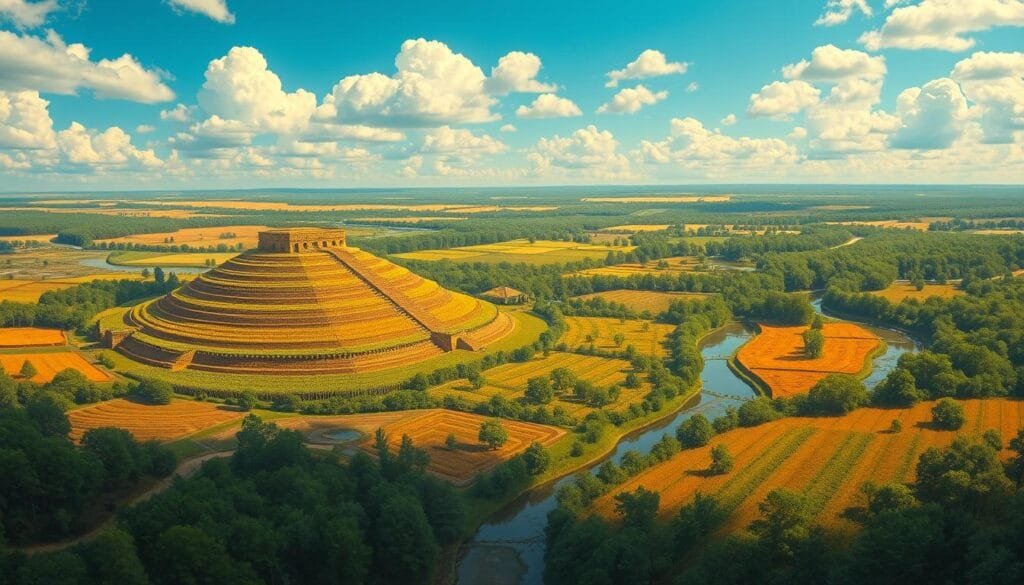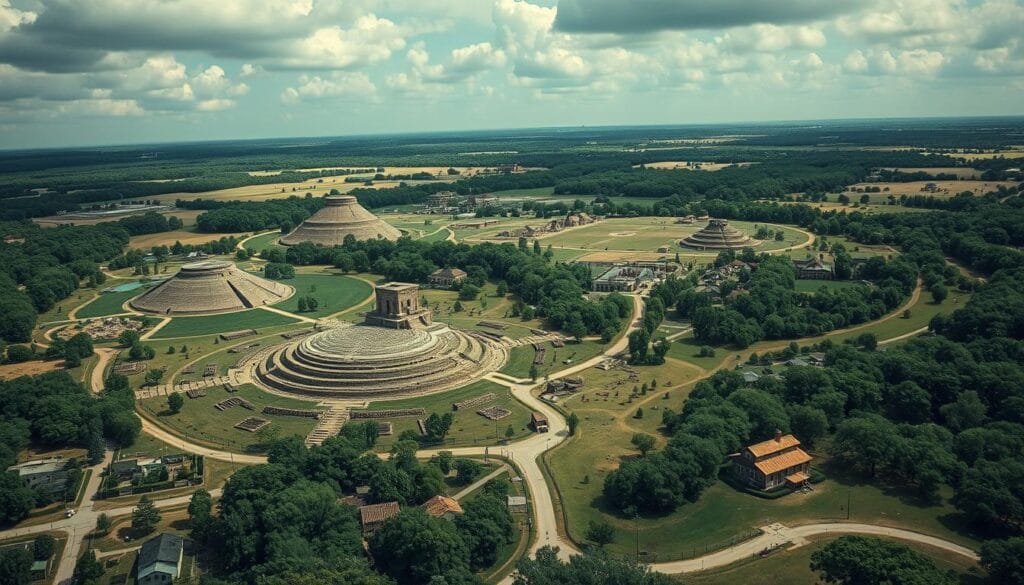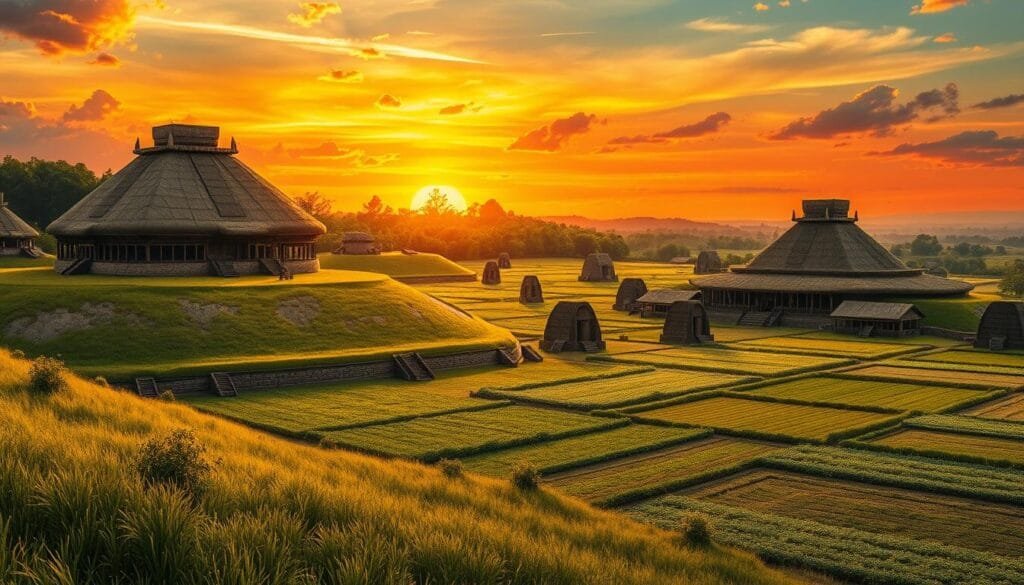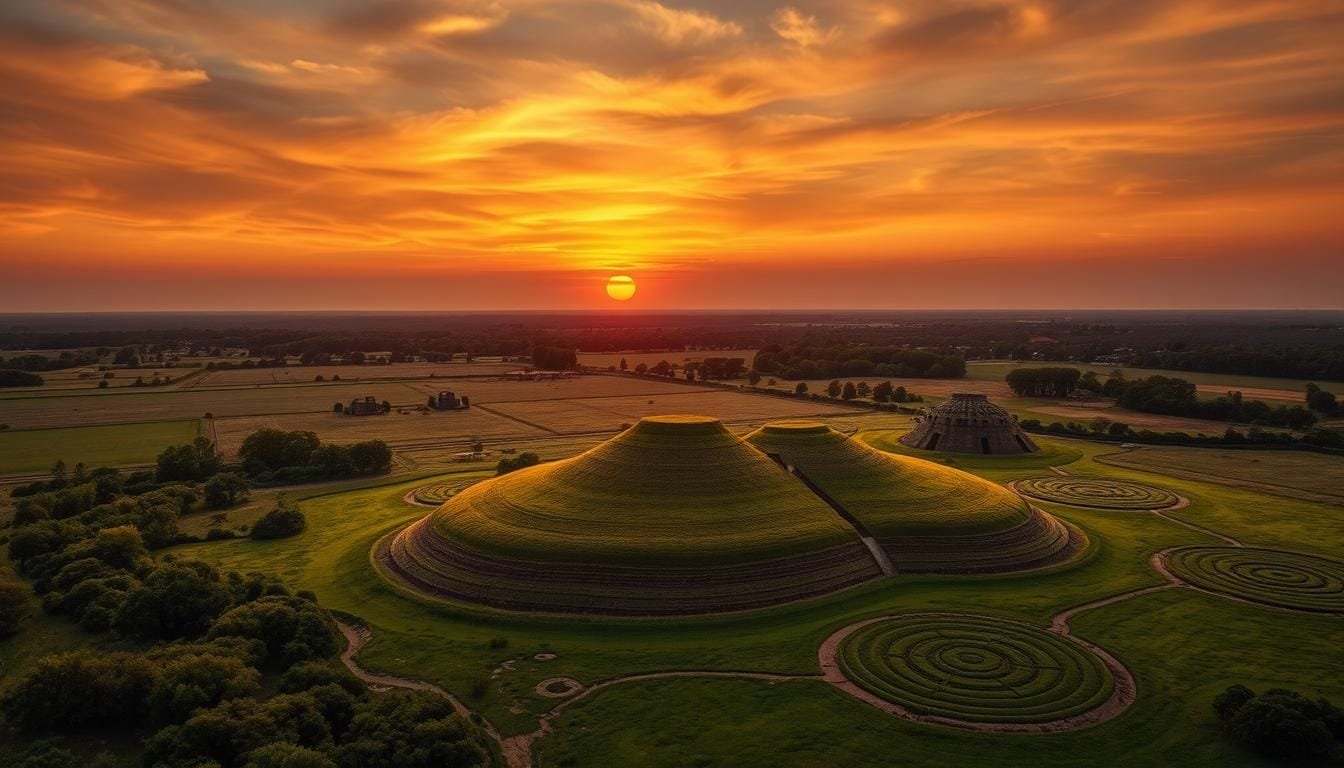We’re diving into the Mississippian culture, focusing on the Cahokia Mounds. This civilization, near today’s St. Louis, shows the brilliance of pre-Columbian societies in North America.
In 1491, over 100,000 people lived in New England’s coastal towns. Similar to these communities, Cahokia’s people made farming essential. This shift marks them as advanced, like the mighty Inca Empire, spanning from the Amazon to the Andes.
The Cahokia civilization, from the 9th to the 15th centuries, was remarkable. Its people achieved great engineering and architectural feats. The Cahokia Mounds are a prime example of their skill in organizing large projects and living sophisticatedly.
The Panther Effigy Pipe from Posey County, Indiana, shows their cultural depth and artistic skill. The Hopewell civilization’s similar artifacts reveal a connection between these ancient groups. This points to common rituals, urban planning, and excellent farming in the Mississippian culture.
Key Takeaways
- The Mississippian culture thrived near modern-day St. Louis, particularly around the Cahokia Mounds.
- In 1491, New England had over 100,000 people, emphasizing the necessity of agriculture.
- Similar to the Inca Empire, Cahokia exemplified complex societal structures and engineering prowess.
- The Mississippian natives showcased agricultural mastery as a staple of their civilization.
- Artifacts like the Panther Effigy Pipe highlight the cultural and artistic sophistication of pre-Columbian societies.
The Rise and Fall of Cahokia
The Cahokia civilization came into power around 700 A.D., quickly becoming a major city of the Mississippian mound-builders. By 1050, it was as big as famous cities like London and Paris, located where the Mississippi, Missouri, and Illinois Rivers meet. Today, the Cahokia Mounds State Historic Site spans 2,200 acres, showing how large the city once was.
Cahokia’s Emergence as a Civilization
The population of Cahokia exploded, growing to cover about 6 square miles with up to 20,000 people living there by 1100 C.E. This growth turned Cahokia into a thriving city known for its impressive planning. Its fertile land and good location helped it grow by making it easy to trade and share cultures.
Excavations show how Cahokia grew from a small community in 700 A.D. to a big city by 1050. In less than 200 years, its population jumped to more than 10,000. This challenges earlier thoughts that overharvesting caused the city’s fall. Instead, it stabilized by the mid-1800s.
Population and Urban Planning
Cahokia’s success was due to smart planning. It had around 120 mounds, showing off their mound-building skills. These mounds proved they were good at building and planning their space, used for living and ceremonies alike. Recent studies have found that Native Americans lived there for much longer than once thought, showing Cahokia wasn’t abandoned early on.
From 1050 to 1100, Cahokia’s population soared to nearly 20,000. This was due to advanced planning, like good farming, trading networks, and social structures. But by 1400 C.E., it had all but vanished, leaving us with big earthworks as clues to its past. Today, experts are trying to figure out why it declined, looking at reasons like wars, environmental issues, and disease.
| Population Growth | Time Period | Area Covered |
|---|---|---|
| 1,400 – 2,800 | Pre-1050 | 1.8 sq km |
| 10,200 – 15,300 | 1050-1100 | 6 sq miles |
| 15,000 – 20,000 | 1100 C.E. | 6 sq miles |
The story of Cahokia’s rise and fall is fascinating. By studying its growth and planning, we learn about the skill and creativity of the Cahokia people. They were a highlight of the Mississippian mound-building era and ancient city design.
Advanced Agriculture and Food Systems
From around 800 to 1540 CE, the Mississippian Period witnessed a major shift. People moved from hunting and gathering to advanced farming. Cahokia’s farming was advanced, using different techniques and tools to boost productivity and secure food. They grew a variety of crops, focusing on staples like maize, squash, and beans.

Role of Women in Agriculture
In Cahokia, women were key to farming’s success. They were experts in crop diversity and ancient food systems. This made them important in their communities. Beyond planting, they also chose and grew both farmed crops and wild plants. Their knowledge kept the food system strong, supporting large communities.
Crop Diversity and Wild Plant Cultivation
Diversity in crops was crucial in Cahokia. Planting different crops, like maize, chenopod, and marshelder, provided a balanced diet. This approach reduced the risk of crop failures. Adding wild plants to their diet made it richer. This helped keep the population healthy and stable. Hutchins’ research shows how varied farming supported Cahokia, similar to major European cities back then.
The table below shows aspects of Mississippian culture’s farming:
| Element | Description |
|---|---|
| Staple Crops | Maize, squash, beans |
| Agricultural Techniques | Advanced cultivation methods, crop rotation, and the use of raised fields |
| Role of Women | Major contributors to crop diversity and food system management |
| Population Support | Enabled large population centers akin to major European cities |
Cahokia’s farming achievements were both technical and social. They highlight the crucial role of women and the need for diverse crops to sustain ancient America’s advanced cultures.
How Do We Know Mississippian Natives Were a Sophisticated Society?
The term Mississippian sophistication tells us a lot through archaeological evidence from Cahokia. This includes their farming, social setup, and building skills. By 800 A.D., they moved from simple farming to big scale maize growing. This meant they could live in one place longer. By 1000 A.D., they had developed a complex society in the Mississippi River valley, with advanced farms.

Cahokia shows just how vast Mississippian culture was. It was the biggest settlement in North America. By 1150 A.D., it had more than 10,000 residents. This required clever city planning and using resources wisely. The huge Monks Mound, over 100 feet high and covering 16 acres, proves their amazing engineering.
Mississippians had big farms and used important materials like copper, lead, and chert. These were vital for making tools and for trade. Their trading networks were impressive. Even without writing, they expressed their beliefs through art on different items. This shows their deep cultural life.
Their skill is also seen in Mississippian sophistication in the pottery they made for storing food and in ceremonies. Things like ear spools and beaded capes, plus tattoos, tell us about their personal and community style.
| Aspect of Society | Evidence | Significance |
|---|---|---|
| Agriculture | Extensive maize horticulture, fertile farmlands | Indicates advanced agricultural practices and food security |
| Population | Cahokia’s estimated population of over 10,000 | Demonstrates urban planning and resource management |
| Engineering | Monks Mound construction | Showcases sophisticated construction techniques |
| Trade | Use of chert, copper, lead, and stone | Highlights economic prowess through region-wide networks |
| Art & Culture | Ceramic pottery, adornments, tattoo patterns | Reflects rich cultural and ceremonial life |
Engineering and Architectural Feats
The people of the Mississippian culture left a lasting mark on the landscape. Their advanced engineering and architecture skills are still admired today. The Cahokia mounds, for instance, show how skilled they were. Some of these mounds are over a hundred feet tall.
Cahokia’s area, covering about six square miles, shows their well-thought-out city planning and intricate designs.

Mound Building and Geometric Designs
The Monks Mound stands out among these structures, showcasing Native American building skills at their best. This mound is large and structured, comparing favorably with some of the world’s greatest architectural feats. They aligned these mounds on cardinal points, showing an understanding of geometry and spatial organization.
Sites like Etowah, Moundville, and Spiro share this building style. This points to a widespread knowledge and technique among different communities.
Mounds served more purposes than just construction. In the Hopewell culture, many were for sacred ceremonies and marking celestial events. These alignments offer insights into their astronomical practices. They observed the stars for religious and daily activities.
Woodhenge and Astronomical Calendars
The Woodhenge is another achievement, showcasing their grasp of astronomy. It’s a calendar made from wooden poles. At Cahokia, it aligns with the equinox sunrises and solstice sunsets. This wasn’t just for keeping time but also played a part in religious and community events.
Mississippian sites show advanced manipulation of landscapes. For example, Cahokia’s North Plaza has mounds on each cardinal point. They combined practical use with religious symbolism in their designs. These landscapes taught about religious beliefs and helped organize society.
The details and alignments in Cahokia and other sites show the spiritual and intellectual lives of these people. For more about the Mississippian culture and its achievements, visit the National Park Service here.
Conclusion
Cahokia is a standout example of ancient Native sophistication in the Mississippian culture. This culture thrived from around 700 CE until Europeans arrived. It spread over many states, including Mississippi, Alabama, and Georgia, and even reached Wisconsin and Minnesota.
Mississippian societies built huge ceremonial plazas and earth mounds, like the impressive Monks Mound in Collinsville, Illinois. Monks Mound is about 1,000 feet long, 700 feet wide, and 100 feet high. This shows their amazing skills in architecture and their strong community life.
The Mississippian people were also great at crafting. They used copper, shell, stone, wood, and clay to make headdresses, weapons, pipes, and masks. These items often featured feathered serpents and winged warriors, showing their artistry and cultural depth. Research on their ceramics and burial practices continues to reveal more about their complex society.
Discoveries by archaeologists and scholars show us the Mississippian civilization’s lasting impact. These findings help us appreciate their contributions to culture and architecture. They also help correct old misunderstandings. Recognizing the Mississippian culture’s achievements lets us honor an important part of Native American history.
FAQ
What is the significance of Cahokia in the context of Mississippian culture?
Cahokia was the largest city north of Mexico in North America before the Europeans arrived. It shows what Mississippian culture was like, with its advanced city planning and big influence in the Midwest. The city had a huge population, even comparing to London at its best.
How did Cahokian society organize its urban planning and population?
Cahokia was known for its dense and well-planned cities. These cities were centers for trade and ceremonies. According to Captain Thomas Hutchins in 1803, it was a big city with organized streets. It had large mounds and a lot of people worked together to build it.
What role did women play in Cahokia’s agricultural practices?
Women played a key role in farming in Cahokia, possibly even leading due to their farming knowledge. They were essential in making a stable food system. This system included corn, chenopod, and marshelder.
Can you elaborate on Cahokia’s crop diversity and agricultural techniques?
Cahokia’s farming was very advanced, with a focus on growing a variety of plants. They also used new farming techniques. This helped feed a lot of people and made the city wealthy.
What evidence supports the sophistication of Mississippian societies like Cahokia?
Exploring old seed stores, analyzing human remains, and looking at artifacts show Cahokia’s complex society. These findings show they had advanced farming and a detailed social system. Women had important roles and there were many different social ranks.
What are some of the engineering and architectural achievements of the Mississippian cultures?
The big mounds in Cahokia, like Monk’s Mound, show brilliant engineering with detailed planning. There’s also Woodhenge, which proves they understood celestial events well. Early maps and digs highlight their skill in making big, astronomically aligned structures.
How did Mississippian natives demonstrate their understanding of astronomy?
They showed their knowledge of the stars with Woodhenge, essentially an astronomy calendar. This structure lined up with key celestial events. It shows how deeply astronomy was woven into their lives and rituals.
